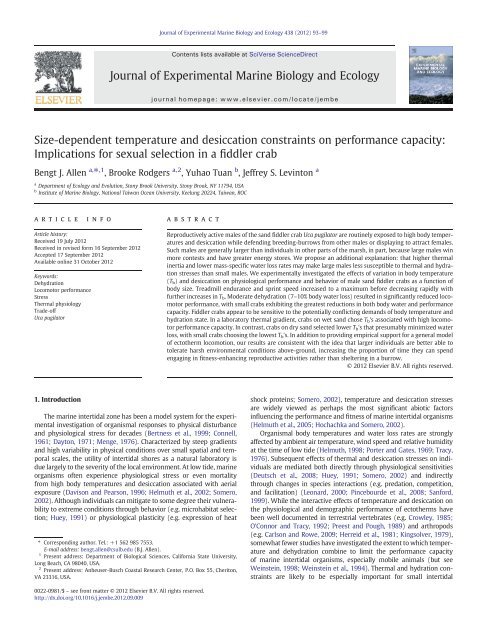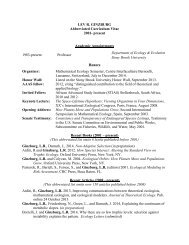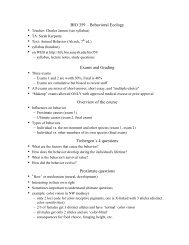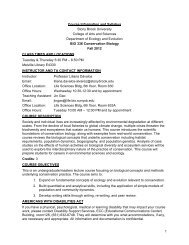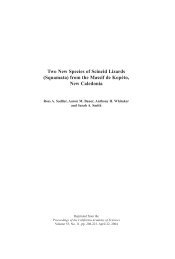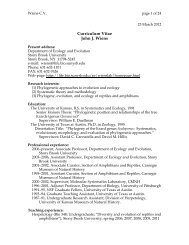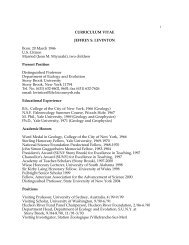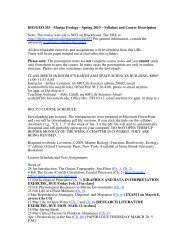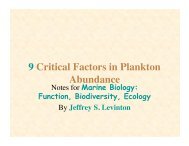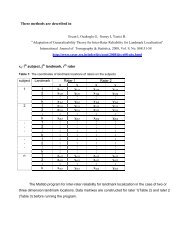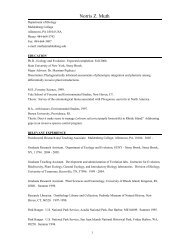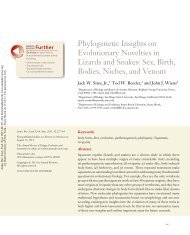Journal of Experimental Marine Biology and Ecology - Stony Brook ...
Journal of Experimental Marine Biology and Ecology - Stony Brook ...
Journal of Experimental Marine Biology and Ecology - Stony Brook ...
Create successful ePaper yourself
Turn your PDF publications into a flip-book with our unique Google optimized e-Paper software.
Size-dependent temperature <strong>and</strong> desiccation constraints on performance capacity:<br />
Implications for sexual selection in a fiddler crab<br />
Bengt J. Allen a, ⁎ ,1 , <strong>Brook</strong>e Rodgers a,2 , Yuhao Tuan b , Jeffrey S. Levinton a<br />
a Department <strong>of</strong> <strong>Ecology</strong> <strong>and</strong> Evolution, <strong>Stony</strong> <strong>Brook</strong> University, <strong>Stony</strong> <strong>Brook</strong>, NY 11794, USA<br />
b Institute <strong>of</strong> <strong>Marine</strong> <strong>Biology</strong>, National Taiwan Ocean University, Keelung 20224, Taiwan, ROC<br />
article info<br />
Article history:<br />
Received 19 July 2012<br />
Received in revised form 16 September 2012<br />
Accepted 17 September 2012<br />
Available online 31 October 2012<br />
Keywords:<br />
Dehydration<br />
Locomotor performance<br />
Stress<br />
Thermal physiology<br />
Trade‐<strong>of</strong>f<br />
Uca pugilator<br />
1. Introduction<br />
abstract<br />
The marine intertidal zone has been a model system for the experimental<br />
investigation <strong>of</strong> organismal responses to physical disturbance<br />
<strong>and</strong> physiological stress for decades (Bertness et al., 1999; Connell,<br />
1961; Dayton, 1971; Menge, 1976). Characterized by steep gradients<br />
<strong>and</strong> high variability in physical conditions over small spatial <strong>and</strong> temporal<br />
scales, the utility <strong>of</strong> intertidal shores as a natural laboratory is<br />
due largely to the severity <strong>of</strong> the local environment. At low tide, marine<br />
organisms <strong>of</strong>ten experience physiological stress or even mortality<br />
from high body temperatures <strong>and</strong> desiccation associated with aerial<br />
exposure (Davison <strong>and</strong> Pearson, 1996; Helmuth et al., 2002; Somero,<br />
2002). Although individuals can mitigate to some degree their vulnerability<br />
to extreme conditions through behavior (e.g. microhabitat selection;<br />
Huey, 1991) or physiological plasticity (e.g. expression <strong>of</strong> heat<br />
⁎ Corresponding author. Tel.: +1 562 985 7553.<br />
E-mail address: bengt.allen@csulb.edu (B.J. Allen).<br />
1<br />
Present address: Department <strong>of</strong> Biological Sciences, California State University,<br />
Long Beach, CA 98040, USA.<br />
2<br />
Present address: Anheuser-Busch Coastal Research Center, P.O. Box 55, Cheriton,<br />
VA 23316, USA.<br />
0022-0981/$ – see front matter © 2012 Elsevier B.V. All rights reserved.<br />
http://dx.doi.org/10.1016/j.jembe.2012.09.009<br />
<strong>Journal</strong> <strong>of</strong> <strong>Experimental</strong> <strong>Marine</strong> <strong>Biology</strong> <strong>and</strong> <strong>Ecology</strong> 438 (2012) 93–99<br />
Contents lists available at SciVerse ScienceDirect<br />
<strong>Journal</strong> <strong>of</strong> <strong>Experimental</strong> <strong>Marine</strong> <strong>Biology</strong> <strong>and</strong> <strong>Ecology</strong><br />
journal homepage: www.elsevier.com/locate/jembe<br />
Reproductively active males <strong>of</strong> the s<strong>and</strong> fiddler crab Uca pugilator are routinely exposed to high body temperatures<br />
<strong>and</strong> desiccation while defending breeding-burrows from other males or displaying to attract females.<br />
Such males are generally larger than individuals in other parts <strong>of</strong> the marsh, in part, because large males win<br />
more contests <strong>and</strong> have greater energy stores. We propose an additional explanation: that higher thermal<br />
inertia <strong>and</strong> lower mass-specific water loss rates may make large males less susceptible to thermal <strong>and</strong> hydration<br />
stresses than small males. We experimentally investigated the effects <strong>of</strong> variation in body temperature<br />
(Tb) <strong>and</strong> desiccation on physiological performance <strong>and</strong> behavior <strong>of</strong> male s<strong>and</strong> fiddler crabs as a function <strong>of</strong><br />
body size. Treadmill endurance <strong>and</strong> sprint speed increased to a maximum before decreasing rapidly with<br />
further increases in Tb. Moderate dehydration (7–10% body water loss) resulted in significantly reduced locomotor<br />
performance, with small crabs exhibiting the greatest reductions in both body water <strong>and</strong> performance<br />
capacity. Fiddler crabs appear to be sensitive to the potentially conflicting dem<strong>and</strong>s <strong>of</strong> body temperature <strong>and</strong><br />
hydration state. In a laboratory thermal gradient, crabs on wet s<strong>and</strong> chose Tb's associated with high locomotor<br />
performance capacity. In contrast, crabs on dry s<strong>and</strong> selected lower Tb's that presumably minimized water<br />
loss, with small crabs choosing the lowest Tb's. In addition to providing empirical support for a general model<br />
<strong>of</strong> ectotherm locomotion, our results are consistent with the idea that larger individuals are better able to<br />
tolerate harsh environmental conditions above-ground, increasing the proportion <strong>of</strong> time they can spend<br />
engaging in fitness-enhancing reproductive activities rather than sheltering in a burrow.<br />
© 2012 Elsevier B.V. All rights reserved.<br />
shock proteins; Somero, 2002), temperature <strong>and</strong> desiccation stresses<br />
are widely viewed as perhaps the most significant abiotic factors<br />
influencing the performance <strong>and</strong> fitness <strong>of</strong> marine intertidal organisms<br />
(Helmuth et al., 2005; Hochachka <strong>and</strong> Somero, 2002).<br />
Organismal body temperatures <strong>and</strong> water loss rates are strongly<br />
affected by ambient air temperature, wind speed <strong>and</strong> relative humidity<br />
at the time <strong>of</strong> low tide (Helmuth, 1998; Porter <strong>and</strong> Gates, 1969; Tracy,<br />
1976). Subsequent effects <strong>of</strong> thermal <strong>and</strong> desiccation stresses on individuals<br />
are mediated both directly through physiological sensitivities<br />
(Deutsch et al., 2008; Huey, 1991; Somero, 2002) <strong>and</strong> indirectly<br />
through changes in species interactions (e.g. predation, competition,<br />
<strong>and</strong> facilitation) (Leonard, 2000; Pincebourde et al., 2008; Sanford,<br />
1999). While the interactive effects <strong>of</strong> temperature <strong>and</strong> desiccation on<br />
the physiological <strong>and</strong> demographic performance <strong>of</strong> ectotherms have<br />
been well documented in terrestrial vertebrates (e.g. Crowley, 1985;<br />
O'Connor <strong>and</strong> Tracy, 1992; Preest <strong>and</strong> Pough, 1989) <strong>and</strong> arthropods<br />
(e.g. Carlson <strong>and</strong> Rowe, 2009; Herreid et al., 1981; Kingsolver, 1979),<br />
somewhat fewer studies have investigated the extent to which temperature<br />
<strong>and</strong> dehydration combine to limit the performance capacity<br />
<strong>of</strong> marine intertidal organisms, especially mobile animals (but see<br />
Weinstein, 1998; Weinstein et al., 1994). Thermal <strong>and</strong> hydration constraints<br />
are likely to be especially important for small intertidal
94 B.J. Allen et al. / <strong>Journal</strong> <strong>of</strong> <strong>Experimental</strong> <strong>Marine</strong> <strong>Biology</strong> <strong>and</strong> <strong>Ecology</strong> 438 (2012) 93–99<br />
organisms that have low thermal inertia <strong>and</strong> a water-permeable integument;<br />
as such, fiddler crabs in the genus Uca are excellent organisms<br />
for testing ideas about environmental constraints on physiology <strong>and</strong><br />
behavior (Edney, 1961; Silbiger <strong>and</strong> Munguia, 2008; Smith <strong>and</strong> Miller,<br />
1973; Thurman, 1998).<br />
The s<strong>and</strong> fiddler crab, Uca pugilator Bosc (Fig. 1), is a small, highly<br />
active semi-terrestrial species that lives in sheltered areas <strong>of</strong> salt<br />
marshes along the Atlantic <strong>and</strong> eastern Gulf coasts <strong>of</strong> North America.<br />
Although non-breeding individuals are typically found foraging near<br />
the waterline or in simple refuge burrows within the marsh vegetation,<br />
reproductive activity is limited to open s<strong>and</strong> flats in the high intertidal<br />
zone (Christy, 1982, 1983; Croll <strong>and</strong> McClintock, 2000; Pratt <strong>and</strong><br />
McLain, 2002). Environmental conditions are generally less stressful at<br />
lower levels in the marsh (Allen, 2007; Bortolus et al., 2002; Reinsel<br />
<strong>and</strong> Rittsch<strong>of</strong>, 1995), however, females strongly prefer to mate with<br />
males controlling specialized breeding burrows high on the shore<br />
because <strong>of</strong> the reduced risk <strong>of</strong> burrow collapse due to tidal flooding.<br />
Males in these locations are exposed to air for long periods <strong>of</strong> time<br />
while using a single greatly-enlarged major claw as a weapon in agonistic<br />
contests with other males for control <strong>of</strong> burrows or in speciesspecific<br />
waving displays to attract receptive females for mating<br />
(Christy, 1978; Crane, 1975; Pope, 2000; Pratt et al., 2003). After mating,<br />
females stay sheltered in the breeding burrow for about two weeks,<br />
brooding their eggs before emerging to release planktonic larvae into<br />
the water (Christy, 1982, 1983). In contrast, males quickly return to<br />
the marsh surface to resume courting <strong>and</strong> fighting during low tide<br />
(Christy, 1978, 1982).<br />
Males in the high intertidal breeding areas, a small subset <strong>of</strong> the total<br />
population, are generally larger <strong>and</strong> have larger claws for their body size<br />
than males in other parts <strong>of</strong> the marsh (Christy, 1983; Pratt <strong>and</strong> McLain,<br />
2002; Pratt et al., 2003). Large males win more contests, display with<br />
greater vigor, <strong>and</strong> are attractive to females (Christy, 1983; Hyatt <strong>and</strong><br />
Salmon, 1978; Pratt <strong>and</strong> McLain, 2002). Presumably, small males are either<br />
quickly evicted from the breeding area by larger individuals<br />
(Jennions <strong>and</strong> Backwell, 1996; Pratt et al., 2003), run out <strong>of</strong> energy<br />
faster (Backwell et al., 1995; Jennions <strong>and</strong> Backwell, 1998; Kim <strong>and</strong><br />
Choe, 2003; Pratt <strong>and</strong> McLain, 2002), or ab<strong>and</strong>on the area after having<br />
little success in attracting a mate (Jennions <strong>and</strong> Backwell, 1998). In<br />
general, small organisms also have lower thermal inertia <strong>and</strong> higher<br />
mass-specific water loss rates than do large ones (Herreid, 1969;<br />
Stevenson, 1985; Yoder et al., 2007). Mating activity by U. pugilator<br />
occurs in mid-summer <strong>and</strong> previous work has shown that both<br />
thermal <strong>and</strong> desiccation stresses to surface-active crabs are potentially<br />
Fig. 1. Male s<strong>and</strong> fiddler crab, Uca pugilator. The greatly enlarged major claw functions<br />
as both a weapon to defend specialized breeding burrows from other males <strong>and</strong> an<br />
ornament to attract females for mating.<br />
Photograph by D. DeLambert.<br />
high at that time (Allen, 2007), suggesting an additional hypothesis to<br />
explain the skewed size distribution <strong>of</strong> males in the breeding area:<br />
small males are more susceptible to thermal <strong>and</strong> hydration stresses<br />
than large males <strong>and</strong> may therefore spend less time active on the<br />
march surface.<br />
Here we experimentally investigate how body temperature <strong>and</strong><br />
dehydration differentially affect the physiological performance <strong>and</strong><br />
behavioral choices <strong>of</strong> male s<strong>and</strong> fiddler crabs as a function <strong>of</strong> individual<br />
body size. We address four specific questions: (1) how does<br />
locomotor performance (endurance capacity <strong>and</strong> sprint speed) vary<br />
as a function <strong>of</strong> crab body temperature; (2) how does desiccation<br />
rate vary as a function <strong>of</strong> crab body size; (3) how does locomotor<br />
performance (endurance capacity) vary as a function <strong>of</strong> crab body<br />
size <strong>and</strong> hydration state; <strong>and</strong> (4) how does crab body size influence<br />
behavioral choices made by fiddler crabs in response to environmental<br />
variation in temperature <strong>and</strong> water availability. We then evaluate<br />
our results in the context <strong>of</strong> the fiddler crab mating system.<br />
2. Materials <strong>and</strong> methods<br />
We collected surface-active male U. pugilator from Flax Pond, a<br />
Spartina alterniflora dominated salt marsh located on the northern<br />
shore <strong>of</strong> Long Isl<strong>and</strong>, New York, USA (40° 58′ N, 73° 08′ W) from June<br />
to September in 2004–2006, during the crab's reproductive season.<br />
Prior to experimentation, crabs were held in the laboratory at 20 °C in<br />
large aquaria with re-circulating seawater <strong>and</strong> fed Tetra<strong>Marine</strong> fish<br />
flakes (Tetra, Blacksburg, VA) ad libitum. All crabs were held without<br />
food for 12 h immediately prior to data collection <strong>and</strong> no animals<br />
were kept for more than 10 days. For the initial experiment on locomotor<br />
performance, we used adult crabs similar in size to larger individuals<br />
displaying in the breeding areas <strong>of</strong> the marsh (carapace width=<br />
19.88 ± 0.91 mm; mean±SD). For subsequent experiments manipulating<br />
desiccation, we either used crabs <strong>of</strong> a range <strong>of</strong> body sizes<br />
(13.8–21.7 mm) or grouped individuals into two size classes: ‘small’<br />
(16.79±1.05 mm) <strong>and</strong> ‘large’ (21.24±0.77 mm) that represent typical<br />
endpoints <strong>of</strong> the local body size continuum <strong>of</strong> reproductively active<br />
males (see also Pratt et al., 2003). For each crab, we measured carapace<br />
width to the nearest 0.01 mm with digital calipers <strong>and</strong> wet body mass<br />
to the nearest 0.001 g with a Sartorius LC 620 D balance.<br />
2.1. Temperature <strong>and</strong> locomotor performance<br />
Individual crabs were run on a motorized treadmill (Pro-Form 285T<br />
modified with a Dayton 4Z861 10:1 speed reducer) at a velocity <strong>of</strong><br />
4 m min −1 (0.24 km h −1 ) at one <strong>of</strong> eight body temperatures (T b=5,<br />
10, 15, 20, 25, 30, 35 <strong>and</strong> 40 °C; n=20 crabs per Tb, 160total).This<br />
velocity represents the mid-range <strong>of</strong> treadmill speeds used by Full <strong>and</strong><br />
Herreid (1984) (0.06–0.40 km h −1 ) <strong>and</strong> is just above a performance<br />
threshold. Individuals running at this speed or higher lose stamina<br />
much faster than crabs running at slower velocities. The treadmill was<br />
located in a temperature-controlled environmental chamber set to produce<br />
the appropriate Tb for crabs in each trial (relative humidity was<br />
40–60% as measured with a h<strong>and</strong>held hygrometer). Prior to being run<br />
to fatigue, crabs were given a 20-min habituation period on the motionless<br />
treadmill. Following the protocol <strong>of</strong> Full <strong>and</strong> Herreid (1984), we<br />
defined fatigue as the time when a crab did not maintain pace with<br />
the treadmill, dragged its abdomen <strong>and</strong> did not respond to prodding<br />
(see also Allen <strong>and</strong> Levinton, 2007). Each crab was subjected to a single<br />
trial. To minimize disturbance to experimental animals, we verified<br />
treatment temperatures by measuring Tb's on a separate set <strong>of</strong> crabs<br />
in each treatment group that were otherwise h<strong>and</strong>led identically to<br />
those described above (n=5 for each Tb, 40 total). Body temperatures<br />
were measured with a digital thermometer <strong>and</strong> penetrating hypodermic<br />
thermocouple probe (accuracy <strong>of</strong> ±0.1 °C; 0.79 mm diameter)<br />
inserted laterally 3–4 mm into the carapace just forward <strong>of</strong> the tip <strong>of</strong><br />
the flexed abdomen.
We determined the relationship between sprint speed <strong>and</strong> Tb for<br />
male U. pugilator by running individuals in a straight raceway at the<br />
same eight Tb's (n=25 crabs per Tb, 200 total). The wooden raceway<br />
measured 1.80 m long×0.20 m wide×0.24 m high, had a running<br />
surface <strong>of</strong> packed s<strong>and</strong> <strong>and</strong> was located in the environmental chamber<br />
described above. We released individual crabs at one end <strong>of</strong> the<br />
track <strong>and</strong> chased them to the other end. As above, each crab was<br />
subjected to a single trial. Trials were recorded from above with a<br />
digital video camera (Canon GL1, recording at 30 frames s −1 ) <strong>and</strong><br />
crab running velocities calculated as the time required to cover a<br />
marked distance.<br />
The upper endpoint on a thermal performance curve is set by the<br />
critical thermal maximum (CT max), the T b at which locomotor performance<br />
is impaired to the point that an organism is effectively unable<br />
to move (Angilletta et al., 2002; Lagerspetz <strong>and</strong> Vainio, 2006). To determine<br />
CTmax <strong>of</strong> U. pugilator, we raised the Tb's <strong>of</strong> (n=10) fiddler<br />
crabs from 20 to 48 °C at a rate <strong>of</strong> 1 °C min −1 with a temperaturecontrolled<br />
water bath. This rate <strong>of</strong> heating is similar to what crabs experience<br />
in the field on warm sunny days (Smith <strong>and</strong> Miller, 1973;<br />
authors' unpublished data). Crabs were kept in a shallow glass dish<br />
containing filtered seawater to a depth <strong>of</strong> 1.5 cm (enough to half<br />
cover the crabs). Starting at 40 °C, crabs were removed from the<br />
water bath every minute, their T b's were measured as above <strong>and</strong> they<br />
were placed on their backs. Individuals that were able to right themselves<br />
were returned to the water bath to continue heating, whereas<br />
those that could not recover within the 1-min interval were removed.<br />
Crabs were typically out <strong>of</strong> the water for less than 15 s at a time. We<br />
calculated CTmax as the mean <strong>of</strong> the Tb's at which individuals were<br />
unable to right themselves (Lagerspetz <strong>and</strong> Vainio, 2006).<br />
2.2. Desiccation <strong>and</strong> locomotor performance<br />
For this experiment, temperature in the environmental chamber<br />
was set at a constant 30 °C. Prior to being run to fatigue, crabs <strong>of</strong> different<br />
sizes (mass=2.74±0.79 g; mean±SD) were given a 20-min<br />
habituation period on the treadmill either immediately following<br />
removal from seawater, or after a 2-h drying period during which<br />
they were exposed to ambient chamber air while sitting in a shallow<br />
open container. The treadmill was held motionless during this time.<br />
A preliminary study found that crabs typically lost 4–10% <strong>of</strong> their<br />
body mass over the 2 h period, depending upon their starting size<br />
<strong>and</strong> presumably representing water loss due to evaporation <strong>and</strong><br />
respiration (Weinstein, 1998; Yoder et al., 2005, 2007). The order in<br />
which crabs were run was r<strong>and</strong>omized with respect to body size<br />
<strong>and</strong> drying time (n=49 ‘no drying’, 36‘2 h drying’).<br />
B.J. Allen et al. / <strong>Journal</strong> <strong>of</strong> <strong>Experimental</strong> <strong>Marine</strong> <strong>Biology</strong> <strong>and</strong> <strong>Ecology</strong> 438 (2012) 93–99<br />
Similar to the temperature experiment, we measured hydration<br />
state <strong>and</strong> T b at the beginning <strong>of</strong> the endurance trials for a separate<br />
set <strong>of</strong> crabs in each treatment group (mass=2.89±0.81 g) that<br />
were otherwise treated identically to those described above (n=40<br />
in both groups). Based on those results, percent water loss was assumed<br />
to be zero for crabs in the ‘no drying’ treatment groups. During<br />
the 20-min habituation period, crabs were enclosed in a small box<br />
under conditions <strong>of</strong> close to 100% relative humidity, limiting water<br />
loss to essentially nil over such a short time interval (Yoder et al.,<br />
2005). Dehydration rate for crabs in the ‘2 h drying’ treatment groups<br />
was calculated as the difference in body mass before <strong>and</strong> after exposure<br />
to air, expressed in units <strong>of</strong> g H2O lost per g crab mass per hour.<br />
2.3. Selected body temperatures<br />
To determine whether body size interacts with hydration state to<br />
influence the thermal preferences <strong>of</strong> fiddler crabs, we estimated the<br />
range <strong>of</strong> body temperatures selected by animals in the absence <strong>of</strong><br />
associated ecological costs <strong>and</strong> constraints — so-called set-point or<br />
target T b's (T set; Hertz et al., 1993; Huey 1991; Huey <strong>and</strong> Slatkin,<br />
1976; Huey et al., 1989) for small <strong>and</strong> large crabs on both wet <strong>and</strong><br />
dry s<strong>and</strong>. We estimated T set by allowing individual crabs to move<br />
about freely in a laboratory thermal gradient before taking their<br />
body temperature. The working section <strong>of</strong> the thermal gradient<br />
consisted <strong>of</strong> an open Plexiglas raceway (1.20 m long×0.10 m<br />
wide×0.10 m high) mounted on a solid aluminum bar (1.80 m<br />
long×0.10 m wide×0.05 m high) covered with a thin layer <strong>of</strong> s<strong>and</strong>.<br />
Each end <strong>of</strong> the aluminum bar was transited by four rigid copper<br />
pipes (1.27 cm (1/2 in.) diameter); heated water was circulated<br />
through the pipes at one end <strong>and</strong> chilled water at the other using<br />
recirculating water baths (Forma Scientific, Marietta, OH), resulting<br />
in substratum temperatures that changed linearly along the length<br />
<strong>of</strong> the bar. Crabs could easily choose a T b from approximately 5 to<br />
45 °C by changing their physical location in the thermal gradient. Individual<br />
male U. pugilator (n=20 per treatment group, 80 total) were<br />
placed at r<strong>and</strong>om inside the Plexiglas raceway <strong>and</strong> allowed to adjust<br />
for 15 min before their body temperature was recorded with the digital<br />
thermometer described above; preliminary studies showed that<br />
this was enough time for them to explore the gradient <strong>and</strong> settle at<br />
a particular Tb. The thermal gradient was located behind an opaque<br />
screen to minimize external stimuli to the experimental crabs. We<br />
defined Tset as the range between the first <strong>and</strong> third quartiles <strong>of</strong> the<br />
distribution <strong>of</strong> all T b's selected in the gradient, a common metric in<br />
studies <strong>of</strong> thermal biology (Blouin-Demers <strong>and</strong> Weatherhead, 2001;<br />
Christian <strong>and</strong> Weavers, 1996; Hertz et al., 1993).<br />
Fig. 2. Mean±SE locomotor performance <strong>of</strong> male Uca pugilator as a function <strong>of</strong> body temperature (T b): (A) endurance capacity; <strong>and</strong> (B) sprint speed. The hatched bars represent the<br />
mid-range <strong>of</strong> T b's selected by male fiddler crabs on wet s<strong>and</strong> in a laboratory thermal gradient (T set; see text for details).<br />
95
96 B.J. Allen et al. / <strong>Journal</strong> <strong>of</strong> <strong>Experimental</strong> <strong>Marine</strong> <strong>Biology</strong> <strong>and</strong> <strong>Ecology</strong> 438 (2012) 93–99<br />
2.4. Statistical analyses<br />
We tested for differences in fiddler crab locomotor performance as<br />
a function <strong>of</strong> T b with one-way analyses <strong>of</strong> variance (ANOVA) with temperature<br />
as a fixed factor. Data were transformed with a ln(x+1)<br />
function to correct for unequal variances <strong>and</strong> non-normality (Sokal<br />
<strong>and</strong> Rohlf, 1995). The relationships between fiddler crab body size<br />
<strong>and</strong> desiccation rate <strong>and</strong> locomotor performance were evaluated<br />
with linear regressions. Size-specific variation in selected Tb's under<br />
different hydration conditions were compared with two-way<br />
Fig. 3. Relationships between mass <strong>of</strong> male Uca pugilator <strong>and</strong> (A) desiccation rate;<br />
(B) endurance capacity immediately following removal <strong>of</strong> crabs from seawater; <strong>and</strong><br />
(C) endurance capacity after 2 h drying in an environmental chamber held at a constant<br />
30 °C.<br />
ANOVA with body size <strong>and</strong> s<strong>and</strong> hydration (wet or dry) as fixed factors<br />
on ln(x+1) transformed data. Post-hoc multiple comparisons following<br />
the two-way ANOVAs were done with Tukey's HSD tests. All<br />
analyses were done with JMP 5.1.<br />
3. Results<br />
3.1. Temperature <strong>and</strong> locomotor performance<br />
There were statistically significant differences in locomotor performance<br />
as a function <strong>of</strong> temperature (endurance: F7, 152=32.58,<br />
pb0.001; sprint speed: F7, 192=130.40, pb0.001). Fiddler crab endurance<br />
capacity was maximized at a Tb <strong>of</strong> 30 °C, while sprint speed was<br />
maximized at 35 °C (Fig. 2A, B). In both cases, locomotor performance<br />
initially improved with increasing Tb, was maximized at an intermediate<br />
Tb, <strong>and</strong> declined precipitously at Tb's above this range. CTmax<br />
for male fiddler crabs in this study was 43.1±0.41 °C (mean±SE).<br />
3.2. Desiccation <strong>and</strong> locomotor performance<br />
Although all crabs had similar hydration states immediately upon<br />
removal from seawater (100% hydrated), during a 2-h period <strong>of</strong> exposure<br />
to air small crabs lost water at a higher proportional rate<br />
than large crabs (Fig. 3A; desiccation rate=0.06−0.01×crab mass;<br />
r 2 =0.45, pb0.001, n=40). While hydrated crabs <strong>of</strong> all body sizes<br />
exhibited Tb's that were 5–6 °C below ambient air temperature due to<br />
evaporative cooling (23.9±0.70 °C; mean±SD), after 2 h <strong>of</strong> aerial<br />
exposure Tb's <strong>of</strong> experimental crabs had increased closer to ambient<br />
(28.0±1.24 °C), presumably due a reduction in the efficacy <strong>of</strong> such<br />
cooling over time. Given the strong temperature dependence <strong>of</strong> locomotor<br />
performance in U. pugilator (Fig. 2A, B; Weinstein, 1998), we decided<br />
to evaluate the relationship between time to fatigue <strong>and</strong> body size<br />
separately for the two groups. There was no effect <strong>of</strong> body size on endurance<br />
capacity <strong>of</strong> hydrated fiddler crabs (Fig. 3B; time to fatigue=<br />
10.23+0.72×crab mass; r 2 =0.01, p=0.594, n=49); in contrast,<br />
there was a positive effect <strong>of</strong> body size on endurance capacity <strong>of</strong> experimental<br />
crabs, with smaller crabs more strongly affected by drying time<br />
(Fig. 3C; time to fatigue=0.45+4.71×crab mass; r 2 =0.24, p=0.002,<br />
n=36), presumably due to their higher rate <strong>of</strong> dehydration.<br />
Fig. 4. Mean±SE body temperatures (T b)selectedbymaleUca pugilator in a laboratory<br />
thermal gradient (T set) as a function <strong>of</strong> body size [small crabs (open bars); large crabs<br />
(hatched bars)] <strong>and</strong> sediment water content (wet s<strong>and</strong> or dry s<strong>and</strong>). Small (carapace<br />
width=16.79±1.05 mm; mean±SD) <strong>and</strong> large (21.24±0.77 mm) size classes represent<br />
typical endpoints <strong>of</strong> the local body size continuum <strong>of</strong> reproductively active males.<br />
Non-overlapping horizontal bars indicate significant differences among treatment groups<br />
at the α=0.05 level with Tukey's HSD test.
3.3. Selected body temperatures<br />
On wet s<strong>and</strong>, the mean Tb selected by small crabs in the thermal<br />
gradient was 27.1 °C (the first <strong>and</strong> third quartiles defining T set were<br />
25.6 °C <strong>and</strong> 28.0 °C), similar to the 26.7 °C (Tset between 25.5 °C <strong>and</strong><br />
28.3 °C) selected by large individuals. In contrast, on dry s<strong>and</strong> the<br />
mean Tb selected by small crabs was 17.5 °C (Tset between 16.1 °C <strong>and</strong><br />
19.0 °C), compared with 19.6 °C (Tset between 17.7 °C <strong>and</strong> 20.7 °C)<br />
for large crabs. The interaction between body size <strong>and</strong> sediment hydration<br />
state (wet or dry) was statistically significant (F1, 76=6.84, p=<br />
0.011). Large <strong>and</strong> small crabs chose similar high Tb's under wet conditions.<br />
In contrast, while crabs <strong>of</strong> all sizes selected lower Tb's under dry<br />
conditions, small crabs chose the lowest (Fig. 4).<br />
4. Discussion<br />
Fiddler crabs exhibited a pattern <strong>of</strong> locomotor performance as a<br />
function <strong>of</strong> T b typical <strong>of</strong> many ectothermic organisms (e.g. Angilletta<br />
et al., 2002; Huey, 1982; Weinstein, 1998). Combined with the results<br />
<strong>of</strong> the thermal gradient experiment, these data suggest that in the<br />
absence <strong>of</strong> competing costs <strong>and</strong> constraints, fiddler crabs can <strong>and</strong> do<br />
select T b's that come reasonably close to optimizing their locomotor<br />
performance (see also Weinstein, 1998). The observation that fiddler<br />
crabs preferentially select T b's slightly below their measured performance<br />
optima is consistent with a new model <strong>of</strong> ectotherm temperature<br />
biology (Martin <strong>and</strong> Huey, 2008). Given that the thermal<br />
dependence <strong>of</strong> ectotherm performance is asymmetric, a Tb higher<br />
than the temperature at which performance capacity is maximized<br />
(Tpmax) is generally expected to reduce performance more than<br />
would a T b the same level below T pmax. Ectotherms are imperfect<br />
thermoregulators that typically experience a range <strong>of</strong> body temperatures<br />
throughout the day. Under these conditions, the optimal body<br />
temperature (that which maximizes total fitness over time) should<br />
not be centered at T pmax (which represents the maximization <strong>of</strong><br />
instantaneous fitness), but rather, shifted to a somewhat lower temperature<br />
(Martin <strong>and</strong> Huey, 2008).<br />
Hydration state <strong>and</strong> body size interacted strongly with fiddler crab<br />
body temperature to influence individual physiology <strong>and</strong> behavior. Variation<br />
in performance (e.g., endurance or sprint speed) presumably relates<br />
to variation in whole organism functional capability, influencing<br />
how an individual's phenotype interacts with their environment<br />
(Arnold 1983). Although locomotor performance <strong>of</strong> small crabs was<br />
comparable to that <strong>of</strong> large crabs when both groups were hydrated,<br />
they did far worse when moderately dehydrated (7–10% water loss)<br />
after 2 h <strong>of</strong> aerial exposure. Under similar environmental conditions,<br />
small crabs experienced greater water loss <strong>and</strong> presumably associated<br />
desiccation stress compared with large crabs. Darnell <strong>and</strong> Munguia<br />
(2011) reported a similar pattern <strong>of</strong> increasing dehydration rate with<br />
decreasing body size for the closely-related fiddler crab U. panacea.<br />
Studies <strong>of</strong> terrestrial locomotion in ghost crabs (Ocypode quadrata),<br />
crayfish (Orconectes rusticus), <strong>and</strong> isopods (Porcellio laevis) havefound<br />
that locomotion is significantly reduced or even ceases when water<br />
loss approaches 10% (Claussen et al., 2000; Dailey et al., 2009;<br />
Weinstein et al., 1994). In ghost crabs (the sister taxon <strong>of</strong> Uca), water<br />
loss <strong>of</strong> only 3.6% initial body weight over a period <strong>of</strong> 90 min decreased<br />
maximum aerobic speed (the rate <strong>of</strong> locomotion at which maximum<br />
oxygen consumption is attained) by 32% relative to hydrated crabs;<br />
maximum aerobic speed was significantly correlated with endurance<br />
capacity (Weinstein, 1998; Weinstein et al., 1994). Effects <strong>of</strong> dehydration<br />
on locomotor performance are influenced by the rate <strong>of</strong> water<br />
loss: more rapid dehydration leads to a greater reduction in performance<br />
capacity, even if the total amount <strong>of</strong> water loss is the same<br />
(Weinstein, 1998). Under typical mid-summer conditions <strong>of</strong> high<br />
solar radiation <strong>and</strong> air temperatures <strong>and</strong> moderate winds, small fiddler<br />
crabs can lose 10% <strong>of</strong> their body water in less than 20 min (authors'<br />
unpublished data), suggesting that in the exposed breeding area<br />
B.J. Allen et al. / <strong>Journal</strong> <strong>of</strong> <strong>Experimental</strong> <strong>Marine</strong> <strong>Biology</strong> <strong>and</strong> <strong>Ecology</strong> 438 (2012) 93–99<br />
surface-active crabs without access to a burrow for refuge might be at<br />
significant risk <strong>of</strong> impairment on many days.<br />
Our results support a general model <strong>of</strong> ectotherm terrestrial locomotor<br />
performance that predicts performance capacity will increase<br />
with Tb at moderate temperatures up to a point, decrease with increasing<br />
dehydration, <strong>and</strong> that the magnitude <strong>of</strong> this decrease will<br />
change depending on Tb (Preest <strong>and</strong> Pough, 1989; Weinstein, 1998).<br />
Mass-specific water loss rates are inversely related to body size in<br />
aquatic <strong>and</strong> semi-terrestrial crabs <strong>and</strong> larger individuals contain<br />
more water overall (Grant <strong>and</strong> McDonald, 1979; Yoder et al., 2010).<br />
As a consequence, under similar environmental conditions, large<br />
crabs stay hydrated longer <strong>and</strong> therefore perform better, than small<br />
crabs. Whereas small males can quickly reach T b's <strong>and</strong> desiccation<br />
levels detrimental to physiological performance, larger males approach<br />
those limits more slowly. Hyatt (1977) observed that large<br />
reproductively-active male U. pugilator spent less time in their burrows<br />
than small individuals <strong>and</strong> suggested that this might be due to<br />
reduced tolerance to thermal <strong>and</strong> desiccation stresses <strong>of</strong> small crabs.<br />
Our data are consistent with this hypothesis. Similarly, Darnell <strong>and</strong><br />
Munguia (2011) showed that the major claw <strong>of</strong> fiddler crabs can function<br />
as a heat sink, transferring heat away from the body such that<br />
large males with relatively larger claws will gain heat more slowly<br />
than small individuals.<br />
Of tropical origin, fiddler crabs are very permeable <strong>and</strong> exhibit<br />
high net water loss rates (Crane, 1975; Thurman, 1998; Yoder et al.,<br />
2005, 2010). The associated high rates <strong>of</strong> evaporative cooling can be<br />
extremely effective at lowering fiddler crab body temperatures in<br />
hot, dry environments such as the high intertidal breeding area<br />
(Edney, 1961; Powers <strong>and</strong> Cole, 1976; Smith <strong>and</strong> Miller, 1973;<br />
Thurman, 1998). The primary limitation <strong>of</strong> such a strategy is the<br />
availability <strong>of</strong> free water to replace that lost to evaporation. Nonreproductive<br />
crabs foraging on creek banks low in the marsh have<br />
easy access to shallow st<strong>and</strong>ing water. Crabs in this microhabitat<br />
are typically active even on hot days when fiddler crabs in other<br />
parts <strong>of</strong> the marsh are in their burrows (Allen, 2007), suggesting<br />
that an ability to remain fully hydrated extends the range <strong>of</strong> environmental<br />
conditions over which crabs can remain on the marsh surface.<br />
In contrast, the main source <strong>of</strong> water to fiddler crabs in the breeding<br />
area is likely to be interstitial water in the burrow. Fiddler crabs, <strong>and</strong><br />
the closely-related ghost crab, O. quadrata, use hydrophilic tufts<br />
<strong>of</strong> setae located at the base <strong>of</strong> their walking legs to efficiently extract<br />
water from damp s<strong>and</strong> (Thompson et al., 1989; Wolcott, 1984). When<br />
surface sediments become dry (as is common in the breeding area;<br />
Allen 2007) crabs can still hydrate effectively within their burrows.<br />
Nevertheless, the need to remain below-ground to do so presents<br />
an opportunity cost to crabs that need to rehydrate frequently, as<br />
they will consequently spend less time participating in reproductive<br />
or foraging activities.<br />
Fiddler crabs appear to be sensitive to the potentially conflicting<br />
dem<strong>and</strong>s <strong>of</strong> body temperature <strong>and</strong> hydration state. Crabs on wet<br />
s<strong>and</strong> in the laboratory chose Tb's associated with high locomotor performance<br />
capacity (Allen, 2007; Weinstein, 1998), while on dry s<strong>and</strong><br />
they accepted lower temperatures that presumably reduced their rate<br />
<strong>of</strong> dehydration due to evaporation. Small crabs, with the highest<br />
mass-specific water loss rates, selected the lowest Tb's on dry s<strong>and</strong>.<br />
Our results suggest that fiddler crabs may be choosing combinations<br />
<strong>of</strong> body temperature <strong>and</strong> hydration state that optimize the joint function<br />
<strong>of</strong> the two variables, rather than either one separately (Huey,<br />
1991; Huey <strong>and</strong> Slatkin, 1976; Huey <strong>and</strong> Stevenson, 1979). While<br />
this may be relatively easy to do in the laboratory in the absence<br />
<strong>of</strong> associated ecological costs <strong>and</strong> constraints, the ability <strong>of</strong> fiddler<br />
crabs to make similar choices in the field will <strong>of</strong>ten be limited by<br />
other factors. The high intertidal breeding area is the only salt<br />
marsh microhabitat with consistently dry sediment <strong>and</strong> high environmental<br />
temperatures, a combination that provides relatively few<br />
opportunities for surface-active crabs to reach their preferred T b.In<br />
97
98 B.J. Allen et al. / <strong>Journal</strong> <strong>of</strong> <strong>Experimental</strong> <strong>Marine</strong> <strong>Biology</strong> <strong>and</strong> <strong>Ecology</strong> 438 (2012) 93–99<br />
contrast, crabs foraging in the lower marsh <strong>of</strong>ten have Tb's within that<br />
range (Allen, 2007). Our data suggest that larger individuals may be<br />
better able to tolerate environmental conditions further from their<br />
optimal state, increasing the proportion <strong>of</strong> time they can spend participating<br />
in fitness-enhancing behaviors such as foraging, burrow<br />
defense, <strong>and</strong> courtship, rather than sheltering underground.<br />
We are certainly not suggesting that existing mechanistic explanations<br />
for the observed surfeit <strong>of</strong> large males in the s<strong>and</strong> fiddler crab<br />
breeding area are incorrect. The importance <strong>of</strong> competitive dominance,<br />
energy stores, <strong>and</strong> attractiveness to females is well documented<br />
(Christy, 1983; Crane, 1975; Jennions <strong>and</strong> Backwell, 1996, 1998; Pratt<br />
<strong>and</strong> McLain, 2002; Pratt et al., 2003). Rather, we wish to raise the possibility<br />
that in addition to the factors listed above, physiological <strong>and</strong><br />
behavioral responses to local environmental conditions might play<br />
an additional <strong>and</strong> even important role in structuring fiddler crab<br />
populations in space <strong>and</strong> time. These constraints may modulate allocation<br />
<strong>of</strong> time by male fiddler crabs to mating activities while in the breeding<br />
area, <strong>and</strong> <strong>of</strong> time spent in the breeding area versus rehydrating <strong>and</strong><br />
feeding in other less physiologically stressful habitats in the marsh. For<br />
example, is it better for a smaller male to attempt to court in hotter,<br />
drier areas where they will encounter more females when they are on<br />
the surface even though the total amount <strong>of</strong> time they can spend on<br />
the surface is limited by temperature <strong>and</strong> desiccation stresses, or to<br />
take a burrow in a cooler <strong>and</strong> wetter peripheral location where the<br />
female encounter rate is lower? <strong>Experimental</strong> manipulations <strong>of</strong> fiddler<br />
crab social context (e.g., male size distributions) <strong>and</strong> environmental<br />
parameters (e.g., levels <strong>of</strong> solar radiation, air <strong>and</strong> sediment temperatures,<br />
<strong>and</strong> water availability) will likely prove to be tractable <strong>and</strong><br />
informative with respect to underst<strong>and</strong>ing the potential importance <strong>of</strong><br />
ecological constraints on mating behavior <strong>and</strong> sexual selection.<br />
Acknowledgments<br />
We are grateful to D. DeLambert for assistance in the laboratory <strong>and</strong><br />
field <strong>and</strong> D. Padilla for many thoughtful discussions. Our manuscript<br />
benefitted from the comments <strong>of</strong> J. Christy <strong>and</strong> several anonymous<br />
reviewers. This work was supported in part by a National Science Foundation<br />
Doctoral Dissertation Improvement Grant (IOB 0508829) <strong>and</strong> a<br />
United States Environmental Protection Agency (EPA) Science to<br />
Achieve Results (STAR) Graduate Fellowship to BJA. EPA has not <strong>of</strong>ficially<br />
endorsed this publication <strong>and</strong> the views expressed herein may not reflect<br />
its views. This is contribution 1219 from the Department <strong>of</strong> <strong>Ecology</strong><br />
<strong>and</strong> Evolution at <strong>Stony</strong> <strong>Brook</strong> University. [SS]<br />
References<br />
Allen, B.J., 2007. Costs <strong>of</strong> sexual selection in the s<strong>and</strong> fiddler crab, Uca pugilator. PhD<br />
thesis, <strong>Stony</strong> <strong>Brook</strong> University, <strong>Stony</strong> <strong>Brook</strong>, NY.<br />
Allen, B.J., Levinton, J.S., 2007. Costs <strong>of</strong> bearing a sexually selected ornamental weapon<br />
in a fiddler crab. Funct. Ecol. 21, 154–161.<br />
Arnold, S.J., 1983. Morphology, performance <strong>and</strong> fitness. Am. Zool. 23, 347–361.<br />
Angilletta, M.J., Niewiarowski, P.H., Navas, C.A., 2002. The evolution <strong>of</strong> thermal physiology<br />
in ectotherms. J. Therm. Biol. 27, 249–268.<br />
Backwell, P.R.Y., Jennions, M.D., Christy, J.H., Schober, U., 1995. Pillar building in the<br />
fiddler crab Uca beebei: evidence for a condition-dependent ornament. Behav.<br />
Ecol. Sociobiol. 36, 185–192.<br />
Bertness, M.D., Leonard, G.H., Levine, J.M., Bruno, J.F., 1999. Climate-driven interactions<br />
among rocky intertidal organisms caught between a rock <strong>and</strong> a hot place.<br />
Oecologia 120, 446–450.<br />
Blouin-Demers, G., Weatherhead, P.J., 2001. Thermal ecology <strong>of</strong> black rat snakes<br />
(Elaphe obsoleta) in a thermally challenging environment. <strong>Ecology</strong> 82, 3025–3043.<br />
Bortolus, A., Schwindt, E., Iribarne, O., 2002. Positive plant–animal interactions in the<br />
high marsh <strong>of</strong> an Argentinian coastal lagoon. <strong>Ecology</strong> 83, 733–742.<br />
Carlson, B.E., Rowe, M.P., 2009. Temperature <strong>and</strong> desiccation effects on the<br />
antipredator behavior <strong>of</strong> Centruroides vittatus (Scorpiones: Buthidae). J. Arachnol.<br />
37, 321–330.<br />
Christian, K.A., Weavers, B.W., 1996. Thermoregulation <strong>of</strong> monitor lizards in Australia:<br />
an evaluation <strong>of</strong> methods in thermal biology. Ecol. Monogr. 66, 139–157.<br />
Christy, J.H., 1978. Adaptive significance <strong>of</strong> reproductive cycles in the fiddler crab Uca<br />
pugilator: a hypothesis. Science 199, 453–455.<br />
Christy, J.H., 1982. Burrow structure <strong>and</strong> use in the s<strong>and</strong> fiddler crab, Uca pugilator<br />
(Bosc). Anim. Behav. 30, 687–694.<br />
Christy, J.H., 1983. Female choice in the resource-defense mating system <strong>of</strong> the s<strong>and</strong><br />
fiddler crab, Uca pugilator. Behav. Ecol. Sociobiol. 12, 169–180.<br />
Claussen, D.L., Hopper, R.A., Sanker, A.M., 2000. The effects <strong>of</strong> temperature, body size,<br />
<strong>and</strong> hydration state on the terrestrial locomotion <strong>of</strong> the crayfish Orconectes<br />
rusticus. J. Crust. Biol. 20, 218–223.<br />
Connell, J.H., 1961. Effects <strong>of</strong> competition, predation by Thais lapillus, <strong>and</strong> other factors on<br />
natural populations <strong>of</strong> the barnacle Balanus balanoides. Ecol. Monogr. 31, 61–104.<br />
Crane, J.C., 1975. Fiddler Crabs <strong>of</strong> the World. Princeton University Press, Princeton.<br />
Croll, G.A., McClintock, J.B., 2000. An evaluation <strong>of</strong> lekking behavior in the fiddler crab<br />
Uca spp. J. Exp. Mar. Biol. Ecol. 254, 109–121.<br />
Crowley, S.R., 1985. Insensitivity to desiccation <strong>of</strong> sprint running performance in the<br />
lizard, Sceloporus undulatus. J. Herpetol. 19, 171–174.<br />
Dailey, T.M., Claussen, D.L., Ladd, G.B., Buckner, S.T., 2009. The effects <strong>of</strong> temperature,<br />
desiccation, <strong>and</strong> body mass on the locomotion <strong>of</strong> the terrestrial isopod, Porcellio<br />
laevis. Comp. Biochem. Physiol. A 153, 162–166.<br />
Darnell, M.Z., Munguia, P., 2011. Thermoregulation as an alternate function <strong>of</strong> the<br />
sexually dimorphic fiddler crab claw. Am. Nat. 178, 419–428.<br />
Davison, I.R., Pearson, G.A., 1996. Stress tolerance in intertidal seaweeds. J. Phycol. 32,<br />
197–211.<br />
Dayton, P.K., 1971. Competition, disturbance, <strong>and</strong> community organization: provision<br />
<strong>and</strong> subsequent utilization <strong>of</strong> space in a rocky intertidal community. Ecol. Monogr.<br />
41, 351–389.<br />
Deutsch, C.A., Tewksbury, J.J., Huey, R.B., Sheldon, K.S., Ghalambor, C.K., Haak, D.C.,<br />
Martin, P.R., 2008. Impacts <strong>of</strong> climate warming on terrestrial ectotherms across<br />
latitude. Proc. Nat. Acad. Sci. U.S.A. 105, 6668–6672.<br />
Edney, E.B., 1961. The water <strong>and</strong> heat relationships <strong>of</strong> fiddler crabs (Uca spp.). Trans. R.<br />
Soc. S. Africa 36, 71–91.<br />
Full, R.J., Herreid II, C.F., 1984. Fiddler crab exercise: the energetic cost <strong>of</strong> running sideways.<br />
J. Exp. Biol. 109, 141–161.<br />
Grant, J., McDonald, J., 1979. Desiccation tolerance <strong>of</strong> Eurypanopeus depressus (Smith)<br />
(Decapoda: Xanthidae) <strong>and</strong> the exploitation <strong>of</strong> microhabitat. Estuaries 2, 172–177.<br />
Helmuth, B., Kingsolver, J.G., Carrington, E., 2005. Biophysics, physiological ecology,<br />
<strong>and</strong> climate change: does mechanism matter? Annu. Rev. Physiol. 67, 177–201.<br />
Helmuth, B., Harley, C.D.G., Halpin, P.M., O'Donnell, M., H<strong>of</strong>mann, G.E., Blanchette, C.A.,<br />
2002. Climate change <strong>and</strong> latitudinal patterns <strong>of</strong> intertidal thermal stress. Science<br />
298, 1015–1017.<br />
Helmuth, B.S.T., 1998. Intertidal mussel microclimates: predicting the body temperature<br />
<strong>of</strong> a sessile invertebrate. Ecol. Monogr. 68, 51–74.<br />
Herreid II, C.F., 1969. Water loss <strong>of</strong> crabs from different habitats. Comp. Biochem. Physiol.<br />
28, 829–839.<br />
Herreid II, C.F., Full, R.J., Prawel, D.A., 1981. Energetics <strong>of</strong> cockroach locomotion. J. Exp.<br />
Biol. 94, 189–202.<br />
Hertz, P.E., Huey, R.B., Stevenson, R.D., 1993. Evaluating temperature regulation by<br />
field-active ectotherms: the fallacy <strong>of</strong> the inappropriate question. Am. Nat. 142,<br />
796–818.<br />
Hochachka, P.W., Somero, G.N., 2002. Biochemical Adaptation: Mechanism <strong>and</strong> Process<br />
in Physiological Evolution. Oxford University Press, London.<br />
Huey, R.B., 1982. Temperature, physiology, <strong>and</strong> the ecology <strong>of</strong> reptiles. In: Gans, C.,<br />
Pough, F.H. (Eds.), <strong>Biology</strong> <strong>of</strong> the Reptilia. : Physiology C. Physiological <strong>Ecology</strong>,<br />
12. Academic Press, New York, pp. 25–91.<br />
Huey, R.B., 1991. Physiological consequences <strong>of</strong> habitat selection. Am. Nat. 137, S91–S115.<br />
Huey, R.B., Slatkin, M., 1976. Costs <strong>and</strong> benefits <strong>of</strong> lizard thermoregulation. Q. Rev. Biol.<br />
51, 363–384.<br />
Huey, R.B., Stevenson, R.D., 1979. Integrating thermal physiology <strong>and</strong> ecology <strong>of</strong><br />
ectotherms: a discussion <strong>of</strong> approaches. Am. Zool. 19, 357–366.<br />
Huey, R.B., Peterson, C.R., Arnold, S.J., Porter, W.P., 1989. Hot rocks <strong>and</strong> not-so-hot rocks:<br />
retreat-site selection by garter snakes <strong>and</strong> its thermal consequences. <strong>Ecology</strong> 70,<br />
931–944.<br />
Hyatt, G.W., 1977. Field studies <strong>of</strong> size-dependent changes in waving display <strong>and</strong> other<br />
behavior in fiddler crab, Uca pugilator (Brachyura, Ocypodidae). Mar. Behav. Physiol.<br />
4, 283–292.<br />
Hyatt, G.W., Salmon, M., 1978. Combat in fiddler crabs Uca pugilator <strong>and</strong> Uca pugnax: a<br />
quantitative analysis. Behaviour 65, 182–211.<br />
Jennions, M.D., Backwell, P.R.Y., 1996. Residency <strong>and</strong> size affect fight duration <strong>and</strong><br />
outcome in the fiddler crab Uca annulipes. Biol. J. Linn. Soc. 57, 293–306.<br />
Jennions, M.D., Backwell, P.R.Y., 1998. Variation in courtship rate in the fiddler crab Uca<br />
annulipes: is it related to male attractiveness? Behav. Ecol. 9, 605–611.<br />
Kim, T.W., Choe, J.C., 2003. The effect <strong>of</strong> food availability on the semilunar courtship<br />
rhythm in the fiddler crab Uca lactea (de Haan) (Brachyura: Ocypodidae). Behav.<br />
Ecol. Sociobiol. 54, 210–217.<br />
Kingsolver, J.G., 1979. Thermal <strong>and</strong> hydration aspects <strong>of</strong> environmental heterogeneity<br />
in the pitcher plant mosquito. Ecol. Monogr. 49, 357–376.<br />
Lagerspetz, K.Y.H., Vainio, L.A., 2006. Thermal behaviour <strong>of</strong> crustaceans. Biol. Rev. 81,<br />
237–258.<br />
Leonard, G.H., 2000. Latitudinal variation in species interactions: a test in the New<br />
Engl<strong>and</strong> rocky intertidal zone. <strong>Ecology</strong> 81, 1015–1030.<br />
Martin, T.L., Huey, R.B., 2008. Why “suboptimal” is optimal: Jensen's inequality <strong>and</strong><br />
ectotherm thermal preferences. Am. Nat. 171, 102–118.<br />
Menge, B.A., 1976. Organization <strong>of</strong> the New Engl<strong>and</strong> rocky intertidal community: role <strong>of</strong><br />
predation, competition, <strong>and</strong> environmental heterogeneity. Ecol. Monogr. 46, 355–393.<br />
O'Connor, M.P., Tracy, C.R., 1992. Thermoregulation by juvenile toads <strong>of</strong> Bufo<br />
woodhousei in the field <strong>and</strong> laboratory. Copeia 1992, 865–876.<br />
Pincebourde, S., Sanford, E., Helmuth, B., 2008. Body temperature during low tide alters the<br />
feeding performance <strong>of</strong> a top intertidal predator. Limnol. Oceanogr. 53, 1562–1573.
Pope, D.S., 2000. Testing function <strong>of</strong> fiddler crab claw waving by manipulating social<br />
context. Behav. Ecol. Sociobiol. 47, 432–437.<br />
Porter, W.P., Gates, D.M., 1969. Thermodynamic equilibria <strong>of</strong> animals with environment.<br />
Ecol. Monogr. 39, 227–244.<br />
Powers, L.W., Cole, J.F., 1976. Temperature variation in fiddler crab microhabitats.<br />
J. Exp. Mar. Biol. Ecol. 21, 141–157.<br />
Pratt, A.E., McLain, D.K., 2002. Antisymmetry in male fiddler crabs <strong>and</strong> the decision to<br />
feed or breed. Funct. Ecol. 16, 89–98.<br />
Pratt, A.E., McLain, D.K., Lathrop, G.R., 2003. The assessment game in s<strong>and</strong> fiddler crab<br />
contests for breeding burrows. Anim. Behav. 65, 945–955.<br />
Preest, M.R., Pough, F.H., 1989. Interaction <strong>of</strong> temperature <strong>and</strong> hydration on locomotion<br />
<strong>of</strong> toads. Funct. Ecol. 3, 693–699.<br />
Reinsel, K.A., Rittsch<strong>of</strong>, D., 1995. Environmental regulation <strong>of</strong> foraging in the s<strong>and</strong><br />
fiddler crab Uca pugilator (Bosc 1802). J. Exp. Mar. Biol. Ecol. 187, 269–287.<br />
Sanford, E., 1999. Regulation <strong>of</strong> keystone predation by small changes in ocean temperature.<br />
Science 283, 2095–2097.<br />
Silbiger, N., Munguia, P., 2008. Carapace color change in Uca pugilator as a response to<br />
temperature. J. Exp. Mar. Biol. Ecol. 355, 41–46.<br />
Smith, W.K., Miller, P.C., 1973. The thermal ecology <strong>of</strong> two south Florida fiddler crabs,<br />
Uca rapax Smith <strong>and</strong> Uca pugilator Bosc. Physiol. Zool. 46, 186–207.<br />
Sokal, R.R., Rohlf, F.J., 1995. Biometry, 3rd ed. W. H. Freeman <strong>and</strong> Co., New York.<br />
Somero, G.N., 2002. Thermal physiology <strong>of</strong> vertical zonation on rocky intertidal shores:<br />
optima, limits, <strong>and</strong> costs <strong>of</strong> living. Int. Comp. Physiol. 42, 780–789.<br />
Stevenson, R.D., 1985. Body size <strong>and</strong> limits to the daily range <strong>of</strong> body temperature in<br />
terrestrial ectotherms. Am. Nat. 125, 102–117.<br />
B.J. Allen et al. / <strong>Journal</strong> <strong>of</strong> <strong>Experimental</strong> <strong>Marine</strong> <strong>Biology</strong> <strong>and</strong> <strong>Ecology</strong> 438 (2012) 93–99<br />
Thompson, W.E., Molinaro, P.J., Greco, T.M., Tedeschi, J.B., Holliday, C.W., 1989. Regulation<br />
<strong>of</strong> hemolymph volume by uptake <strong>of</strong> s<strong>and</strong> capillary water in desiccated fiddler crabs,<br />
Uca pugilator <strong>and</strong> Uca pugnax. Comp. Biochem. Physiol. A 94, 531–538.<br />
Thurman, C.L., 1998. Evaporative water loss, corporal temperature <strong>and</strong> the distribution<br />
<strong>of</strong> sympatric fiddler crabs (Uca) from south Texas. Comp. Biochem. Physiol. A 119,<br />
279–286.<br />
Tracy, C.R., 1976. A model <strong>of</strong> the dynamic exchanges <strong>of</strong> water <strong>and</strong> energy between a<br />
terrestrial amphibian <strong>and</strong> its environment. Ecol. Monogr. 46, 293–326.<br />
Weinstein, R.B., 1998. Effects <strong>of</strong> temperature <strong>and</strong> water loss on terrestrial locomotor<br />
performance in l<strong>and</strong> crabs: integrating laboratory <strong>and</strong> field studies. Am. Zool. 38,<br />
518–527.<br />
Weinstein, R.B., Full, R.J., Ahn, A.N., 1994. Moderate dehydration decreases locomotor<br />
performance <strong>of</strong> the ghost crab, Ocypode quadrata. Physiol. Zool. 67, 873–891.<br />
Wolcott, T.G., 1984. Uptake <strong>of</strong> interstitial water from soil: mechanisms <strong>and</strong> ecological<br />
significance in the ghost crab Ocypode quadrata <strong>and</strong> two gecarcinid l<strong>and</strong> crabs.<br />
Physiol. Zool. 57, 161–184.<br />
Yoder, J.A., Reinsel, K.A., Welch, J.M., Clifford, D.M., Rellinger, E.J., 2005. Herding limits<br />
water loss in the s<strong>and</strong> fiddler crab, Uca pugilator. J. Crustac. Biol. 25, 141–145.<br />
Yoder, J.A., Tank, J.L., Rellinger, E.J., Moore, B.E., Gribbins, K.M., 2007. Differences in<br />
body size <strong>and</strong> water balance strategies between North Carolina <strong>and</strong> Florida<br />
populations <strong>of</strong> the s<strong>and</strong> fiddler crab, Uca pugilator. J. Crust. Biol. 27, 560–564.<br />
Yoder, J.A., Bosley, J.W., Chambers, M.J., Hart, C.E., Gribbins, K.M., Collier, M.H., 2010.<br />
Reduced cuticular permeability promotes inl<strong>and</strong> habitat expansion <strong>and</strong> freshwater<br />
survival in the fiddler crab Uca minax but not in its less terrestrial counterparts<br />
U. pugilator <strong>and</strong> U. pugnax. Crustaceana 83, 481–492.<br />
99


